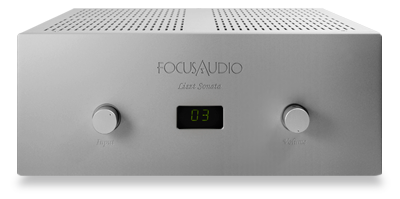
 You say you want a great-sounding amplifier? One that conveys the soul, the breath, the very life of the music? That’s easy. It was first designed in the late 1950s, it’s tried and true, and it’s not really that complicated: two EL34 tubes per channel, a power transformer, and two output transformers. There. Everyone can go home now.
You say you want a great-sounding amplifier? One that conveys the soul, the breath, the very life of the music? That’s easy. It was first designed in the late 1950s, it’s tried and true, and it’s not really that complicated: two EL34 tubes per channel, a power transformer, and two output transformers. There. Everyone can go home now.
I apologize for my flippancy, but hey -- it’s true. And if it’s true that there’s nothing new under the sun, and that most of the good ideas have already been thought, that goes twice for audio. The loudspeaker is over 100 years old, and those high-tech-looking electrostatics are older than I am.
Tube amps have been around since the ’20s, and it’s not a far stretch to say that the technology reached its maturity in the 1950s. Heck, look at any solid-state amplifier now on the market: it employs principles that were new 50 years ago. So, barring new takes on old technology -- and there are some -- high-end audio is mostly about refining principles that are older than most people alive today. That’s why transistors are still here, and tubes as well.
Here I am in the 21st century, and other than a couple of short dalliances with solid-state, my system has been exclusively tube-based for the last 20 years. There’s a good reason for that: I listen to more music when my system is glowing. It’s that simple. I want to listen to tube-amplified music. And the tube amp in my system right now is a doozy.
Late last year, Doug Schneider alerted me to Focus Audio’s Liszt Sonata. “They’re building an amp,” he told me. “They’re building it here. In Canada. Out of Canadian parts.” He paused to let the concept sink in.
Description
At first glance, the Liszt Sonata ($12,000 USD) is a stout, well-built, well-finished, somewhat spartan-looking box. Chassis and case are made of silver-anodized aluminum; they feel extremely well put together.
It’s got the controls you need and little more. Up front you gotcher volume and selector knobs, a minimalist digital display, and that’s it. The power switch is a rocker at the top of the rear panel. There are one balanced and three single-ended inputs, as well as a very handy set of single-ended and balanced inputs that bypass the preamp section. This means that you can use the Liszt Sonata as a power amp, or -- as I did -- feed it the front-channel preamp outputs from my Anthem MRX 300 A/V receiver for home-theater use. Despite the inclusion of balanced inputs, the Liszt Sonata’s circuitry isn’t balanced. The rear panel sports a set of very high-quality binding posts for both 4- and 8-ohm speakers.
The Liszt Sonata uses two EL34 output tubes per channel, driven in class-AB for a total output of 35Wpc. The driver stage comprises two 12AU7s and one 12AX7. All tubes are from Electro-Harmonix. Since the amplifier is auto-biasing, you can jam in any make of power tube you wish, so long as you stick to EL34s.
Focus Audio also makes the Liszt Prelude integrated ($7800), which uses lower-spec transformers for a slight reduction in power, to 32Wpc, as well as lower-spec caps and resistors than the absurdly expensive devices that drive the price of the Sonata into five figures.
Like any good 21st-century integrated, the Liszt Sonata can be remotely controlled, and Focus Audio includes a nifty Apple remote. With this you can change and mute the volume, switch between inputs, and dim the display -- which, Focus suggests, improves the sound.
I’ve harped on a fair amount about the Liszt Sonata’s Canadian origins, and perhaps you feel I’m making a bit more of that than is strictly reasonable. Putting aside for the moment nationalistic pride, I think you might agree that there is some significant value in being able to walk right up and shake hands with the guys who built your $12,000 amplifier. Stretching the concept somewhat, it’s possible to actually get in the same room with the people who are largely responsible for making 80% of the parts that go into this thing.
Big, fat, hairy deal, you might think. Who cares where the amp is made, so long as it’s well made? But would you say that about a watch? A watch that’s built in Basel, Switzerland, seems, for some reason, much more desirable than a Japanese Seiko. I own an Omega Speedmaster and a Seiko Monster. The Seiko is almost as well built as the Omega, keeps time as well, and feels much more rugged. I could own 20 Seikos for the same price as that Omega, but my heart lies with the Swiss watch. So why is the Omega my favorite?
An amplifier that’s made in China will perform the same tasks as one made in Canada. However, perceived value is still value. $10,000 in cash is worth the same to the bank as $10,000 in gold, but which feels better in the hand? The gold just feels more valuable.
The Liszt Sonata exudes the same feeling of value as that $10k chunk of gold, as that Swiss watch.
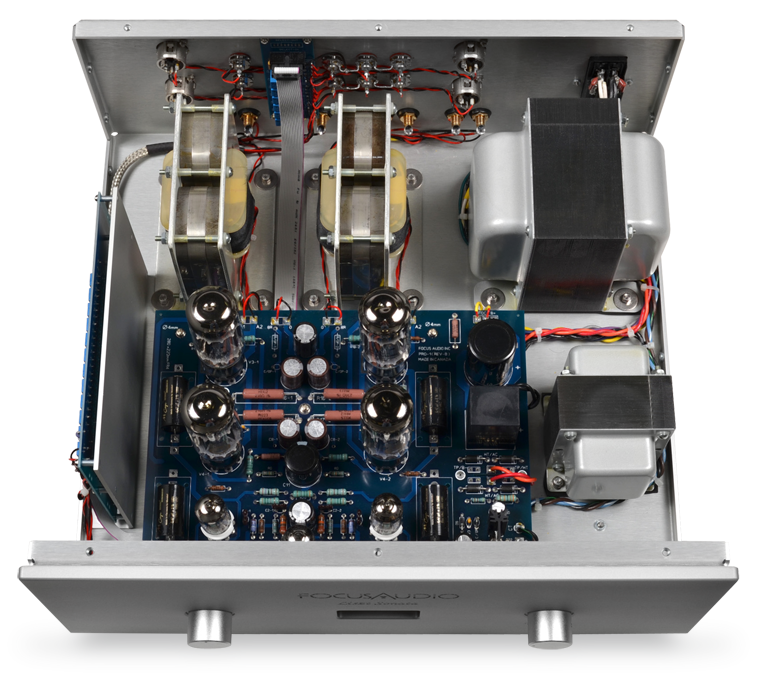
Pop the hood on the Liszt Sonata and you’ll see why it’s a five-figure amp. The transformers are very, very large, looking more like the ones in my 100Wpc Audio Research VT100 than those usually found pushing four EL34s. And those transformers are very hi-spec units. The output transformers are double C-cores, and they’re as big as they are to prevent saturation at low frequencies. Focus Audio claims that the Liszt Sonata’s frequency response at its rated power is essentially flat from 20Hz to 20kHz.
Focus hand-solders the 24-step, relay-controlled, ladder volume attenuator, using high-end tantalum resistors. This type of volume control is made of expensive parts and is extremely labor-intensive to assemble, which make it very costly to build. It’s also arguably the best-sounding way to control volume. The coupling capacitors are Mundorf silver-gold-oil jobbies. It’s all high-end stuff in here, folks.
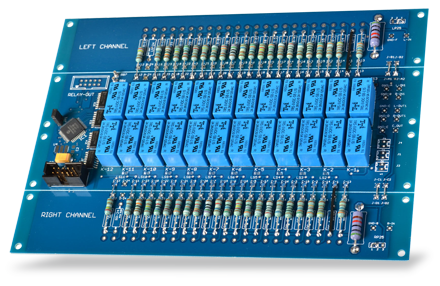
In use, the Liszt Sonata was as simple as possible while still performing its functions. Attach your source and your speakers and off you go. When the amp is powered up, the volume automatically defaults to zero, which was the only aspect of its operation I found annoying. I’d much prefer the level to stay right where I left it the last time I used it.
I hooked up my Aqvox phono stage, using its balanced outputs directly into the Liszt Sonata, then lashed up Totem Acoustic’s Element Ember bookshelf speakers to the amp’s 8-ohm taps with Nordost Frey cables and booted up the system. It took only seconds to realize that the Liszt Sonata was a firecracker, a Corvette, a habanero pepper.
Listening
Even now, months after hearing that first track I played -- “Straightface,” from Son Volt’s Wide Swing Tremolo (LP, Warner Bros. 47059-1) -- I clearly recall how my eyes narrowed to slits as I looked askance at the system. Obvious, overt, rich, tonally complex, tubular music replaced the essentially neutral sound carefully and accurately doled out by my Sonic Frontiers SFL-2 preamp and Audio Research VT100 amp. Wide Swing Tremolo is something of a watershed album in my collection. In my mind I can hear groups such as the Decemberists paying homage to this incredibly literate, intellectual album of country-tinged rock. It’s beautifully recorded and mastered (the LP, anyway), and it was instantly obvious to me how the Liszt Sonata curled itself around the guitar’s harmonics and revealed every burnished cymbal stroke. I could easily live with this amp, I thought.
The situation rapidly evolved. Whenever I want to determine whether a component can communicate the heart and soul of music, I slap Astor Piazzolla’s Tango: Zero Hour (LP, Pangea PAN-42138)on the Pro-Ject and sit back with my arms crossed. “Impress me,” I challenge it.
I could finish the review right here by deconstructing each instrument, every moment of import and meaning in “Milonga del Angel.” If this six-minute piece of music does not move you almost to tears you are not human. The instruments harmonize and blend very subtly. There are times when the piano, bass, bandoneón, and violin join in a cohesive whole so laden with emotion it’s scary. Lesser components tend to muddy the distinctions between instruments -- or, worse, separate them so distinctly that the cohesion that forms the basis for the heartbreak of tango is lost.
The Liszt Sonata exposed the meat on the violin’s bones, showing me just how much rosin and juice comes off those strings. At the same time, it fleshed out each piano note, layering the two instruments on top of each other so that they played as a whole. I found I could easily change my aural focus to clearly grasp each note, if I wanted to. Focus states that the Liszt Sonata will push 20Hz-20kHz at full rated power. I certainly heard no rolloff in the highs. This was not a polite amplifier.
And when Piazzolla’s bandoneón entered, I wanted to fall in love, commit suicide, eat a steak, destroy the world. Via the Liszt Sonata I could hear and feel the rush of air across the reeds, sense Piazzolla’s fingers on the buttons, his very intent. The Liszt Sonata dredged up more texture, detail, and richness from this instrument than has any other amplifier I’ve heard. How it accomplished that is very important to me and to you, and is the meat of this review.
There’s no question that tubes inject a unique character into the music they reproduce. This is not the place to argue about whether this tube character is accurate or appropriate, valid or invalid. Some like it, some don’t. I love the sound of tubes, and seek it out every chance I get. The Liszt Sonata exuded tube character, and it did it well. More important, it accomplished this without falling prey to any of the flaws that define the worst aspects of tubes.
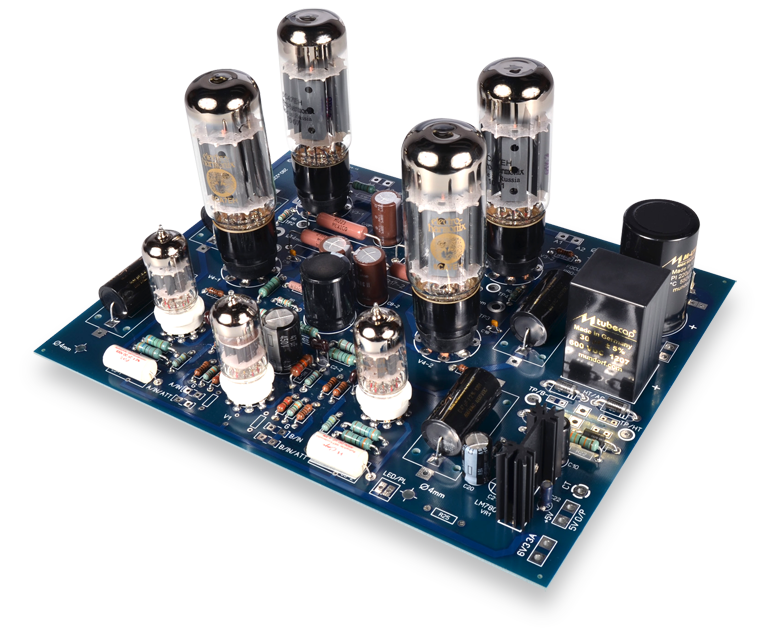
Tubes are rolled off in the treble. Their bass is flabby. They can’t do dynamics. While some tube amplifiers work around these limitations, they generally end up sounding more like solid-state. The Liszt Sonata shatters these paradigms. When Kam Leung, Focus Audio’s head engineer, originally handed off the amp to me, he told me to prepare myself for astonishing bass from a tube amplifier. Yeah, right. We’ll see, I thought, politely nodding.
I’ll be damned if he wasn’t right. I spent time listening to “The Ocean Is the Ultimate Solution,” from Frank Zappa’s Sleep Dirt (LP, Discreet DSK-2292). The bass really drives this track, and it’s not forgiving of any flab or slop in an audio system. The Liszt Sonata displayed outstanding grip and drive, controlling the Totems’ woofers with aplomb. Here’s a judgment call you’ll need to make: The Liszt Sonata’s bass leaned to the warm side when compared to a solid-state amplifier. The Focus didn’t have quite the crisp start-and-stop delineation of bass notes that a higher-powered silicon amp can display. Instead, it imparted a feeling of humanity and realism that can be missing with bigger solid-state amps. Which is correct? The Liszt Sonata delivered my preferred sonic worldview, but I can’t honestly tell you that the other side is wrong.
The strictly acoustic Tango: Zero Hour is insanely dynamic, with low, soft, almost tender passages that explode into loud, frenzied anger and chaos. The Liszt Sonata conveyed these dynamic contrasts in an astonishing manner. First off, the Focus was very, very quiet, with almost no “tube rush” -- I had to put my ear right up against a tweeter before I heard anything. Even with my ear only 2” away from the speaker, I heard nothing. This silent background worked with those big-ass transformers to allow the amp to accelerate at a high-speed rate up to its rated power output -- and a bit beyond, I imagine.
With the Focus driving the Totem Embers, I had no dynamic limitations. I could play as loudly as I cared, both for two-channel and home-theater use. The Ember is a fairly easy load, but I’m not an easy user. I often listen loud, and I like full-scale rock and jazz. There was never a moment with these speakers when I wished for more volume or more power.
Later in my listening I received a set of Monitor Audio PL200 speakers, a match that didn’t work so well. The PL200s don’t exactly look like an easy load for a 35Wpc tube amp: two woofers and a ribbon tweeter. I spent a fair amount of time trying to like this combo, but I just couldn’t get it to work. This isn’t an indictment of either product. Instead, it’s a reality check. Sometimes, you just need more power.
My dissatisfaction with the Focus-Monitor combination got me thinking about speakers, and then I remembered that making speakers is, first and foremost, what Focus Audio does. A quick call to the company resulted in delivery of a pair of fairly large, prototype bookshelf speakers. These, built with Focus’s typical attention to detail, feature a beryllium tweeter, a first for the company. Kam Leung was cagey when I tried to pin him down as to whether this speaker will make it to production, but based on my listening, I’d wager that you’ll see it go live sooner rather than later.
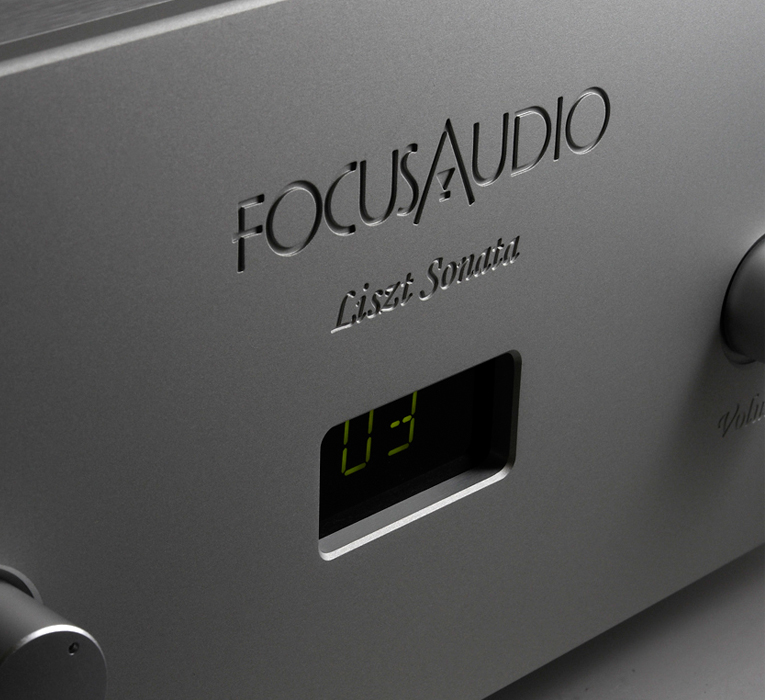
Anyway, I inserted the Focus speakers into the system with the Liszt Sonata, hoping for synergy. I got it. This is an amp review -- I don’t want to get too deep into the sound of these speakers, which anyway were prototypes -- but part of any amp review is how it interacts with speakers. Imagine a system where it all comes together: a low end that’s pretty serious, considering it’s coming from a bookshelf speaker; extended, grain-free, liquid treble; that luscious, elegant tube midrange; and imaging that repeatedly made me shake my head in astonishment.
Listening to Chet Baker’s Chet (LP, Riverside/Analogue Productions APJ 016) is like getting an IV feed of white wine and butter. It’s so rich and overpoweringly decadent, both the music and the recording itself, that it’s almost a cartoon. What saves this recording from itself is the spare delicacy of Baker’s burnished, caramel-coated trumpet. It’s easy to overcook the already tube-heavy sound of “How High the Moon,” and though the Liszt Sonata railed a fairly straight line through this track, I could tell that it was imprinting its own unique mark.
I’d be remiss in my job as a reviewer if I didn’t warn you that the Liszt Sonata doesn’t sound exactly neutral. If you come from a world of solid-state amplification and you like that sound, you may well find the Sonata not to your taste. I found it fairly easy to tell that it was injecting a layer of harmonics that probably isn’t on the recording.
But wait a minute -- repeated listenings and ruminations leave me wondering if maybe the Liszt Sonata’s sound, harmonics and all, isn’t closer to reality than that of an accurate, sterile, solid-state amplifier. The recording process, no matter how carefully done, is flawed. It’s dead easy to hear the difference between live and reproduced sound, and we music lovers spend long hours and many coupons trying to create the illusion of live music in our listening rooms. To my mind, there’s no question that music reproduced by the Liszt Sonata felt more alive, more real, than through any other amp I’ve had in my system.
Wrap it up. I’ll wear it home.
By omitting from the Liszt Sonata such flavor-of-the-day features as a DAC, network connectivity, or a touchscreen -- everything other than the functions necessary for elegant two-channel sound -- Focus Audio has avoided dating this model. Take a look at the used audio market and you’ll see a boatload of last year’s Rube Goldberg devices going for pennies on the dollar, and even a few contraptions from a decade or so ago, such as VHS players and cassette decks, that you can’t even give away.
But look further back, at what was hot in the 1950s and ’60s. Today, there’s a hopping trade in vintage tube audio. Hardcore music lovers still buy and refurbish olde-tyme Dynaco Stereo 70s, and they’re selling for more now than they did when new. The buyers aren’t really collectors. They’re people who’ve listened to this stuff, and who know that two-channel audio reached a kind of pinnacle with the EL34 pentode amplifier.
Look forward 50 years. I’m wary of comparing the Liszt Sonata to a Stereo 70 -- the Focus is a gazillion times better built, and a far more ambitious product -- but I wager that, in the next few decades, audio enthusiasts will look back at this clean, elegantly designed, beautifully made amplifier as a classic of the early 21st century.
. . . Jason Thorpe
jasont@soundstagenetwork.com
Associated Equipment
- Analog source -- Pro-Ject RPM 10 turntable, Roksan Shiraz cartridge
- Digital source -- Logitech Squeezebox Touch
- Phono stage -- Aqvox Phono 2 CI
- Preamplifier -- Sonic Frontiers SFL-2
- Power amplifier -- Audio Research VT100
- Integrated amplifier -- Peachtree Audio decco2
- A/V receiver -- Anthem MRX 300
- Speakers -- Definitive Technology Mythos STS, MartinLogan Ethos, Focus Audio bookshelf prototypes
- Speaker cables -- Analysis Plus Solo Crystal Oval 8, Nordost Frey
- Interconnects -- Analysis Plus, Nordost Frey
- Power cords -- Nordost Vishnu, Shunyata Research Taipan
- Power conditioners -- Quantum QBASE QB8, Shunyata Research Hydra Model-6
Focus Audio Liszt Sonata amplifier
Price: $12,000 USD.
Warranty: Two years parts and labor.
Focus Audio
43 Riviera Drive, Unit 10
Markham, Ontario L3R 5J6
Canada
Phone: (905) 415-8773
Fax: (905) 415-0456
E-mail: contact@focusaudio.ca
Website: www.focusaudio.com






















